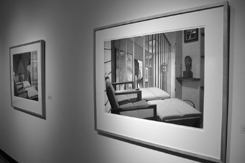Jim Richard and His ‘Good Life’
by Amie Johnson

Two of Jim Richard´s works at the Abercrombie Gallery. Media credit: Amie Johnson
Distinguished artist Jim Richard has invited us into his rooms but does not allow us to enter. What can almost be described as a life-long obsession, his work, which will hang at the Abercrombie Gallery through Oct. 20, deals with organic and man-made structures and pokes fun at what Richard describes as “the good life.”
Born in Port Arthur, Texas, which is also the hometown of admitted influence Robert Rauschenberg, Richard was the first of his family to attend college, where he became interested in being a working artist.
During a lecture about his life and career as part of the Tuminello Visiting Artist Lecture Series, Richard described his young self as “the weird one who didn”t want to work in a refinery.”
While attending graduate school at the University of Colorado-Boulder, he began to understand what an impact his work could have in the world after having a painting selected for a show in New York. “I realized that this work could travel, I could be a part of a bigger picture (and) that this little painting made on the bayou could end up in New York. It did me a world of good.”
Forcing together elements of visual culture, Richard’s colorful, richly detailed paintings of rooms resemble showcase interiors from Home and Garden magazine.
Making references to social hierarchy and upscale taste, the rooms are impenetrable, unpeopled, and stuffed with possessions. Period furniture, grand fireplaces, pattern-upon-pattern wallpaper and fabric only marginally describe Richard’s rooms.
Gaining access to the interiors becomes difficult when the view is obscured by giant chandeliers or heavy pieces of modern sculpture.
Drawing upon a wide variety of influences, including abstract and pop-art painting, Richard, who developed this theme during the 70s, is interested in the idea of “living with art, living with modern sculpture.”
Most of his room paintings feature paintings themselves.
“I am interested in inserting art within art, filling up all the visual space. You know when you are watching a movie, and the people in the movie begin to watch a movie; I always loved the second movie,” said Richard.
These domestic interiors are the showplaces of collectors, and the collectors of Richard’s paintings own jokes at their own expense.
Working in acrylic, oil, felt-tip pen, collage and screen-printing, Richard’s scale varies as much as his medium.
Sized only several inches to several feet, Richard’s paintings remarkably maintain a strong impact despite the scale change.
In “Facing the Collection,” Richard frames the painting dead center. In the foreground is a large, corporate-looking sculpture above which hangs an abstract painting in a wide, gilded frame.
In order to see into the room, you have to look around the edges of the sculpture, an uncomfortable effect. To the left are a small table, a 1950s retro lamp, a vase with roses, and more generic, graphic paintings, all with the overwhelming backdrop of patterned wallpaper.
The space is completely filled; there is no room for people in this world.
Refined and phony, pop and historical, Richard melds styles together in an architectural, cunning parody. The underlying principles of the pastiches force the viewer to bear responsibility for our tastes and desire for “the good life.”
